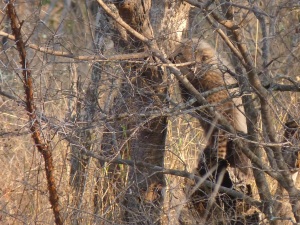My workplace is pretty cool
Unlike most of the previous blog-worthy sightings, this week’s ones occurred at our workplace. On a side note, I like using the word ‘workplace’. For many, it will evoke an image of an office or another indoor environment, which reminds me of the fact that – yup, I’m in South Africa, out in the bush, in lovely weather (usually) and seeing a variety of exciting animals. Anyway, enough gloating and back to the topic of the post … exciting animals this week!
Recently I’ve been spending a lot of time with our newest habituated group, getting sound recordings as they forage or go on sentinel (looking out for predators on behalf of the whole group). At one point, they had taken me into a new part of their territory (we didn’t even know that it was part of theirs!) and were latrine-ing at a rock. As I watched, I noticed something odd. They were also taking turns to investigate something under the rock, scrabbling away at the gap at the base of it. When I got slightly closer, I could hear a noise that sound like deep breathing. It reminded me of Darth Vadar, but I soon realised that it must be a puff adder. Apparently, mongoose will mob snakes whenever they can, to encourage the snake to move on. I have to admit, I felt quite sorry for the snake. There it was, just having a nice sleep under a rock, then it gets disturbed and harassed by this group for over ten minutes! Poor thing.
The main big sighting of the week was Nyala’s (like I said previously, I’m using code names for the others here). As she was weighing the mongoose group she was with, they started alarming at something. A common practice for them, and usually at something very uninteresting – they’ve been known to alarm at hornbills, who they co-forage with, so I don’t always trust their alarm calls. Naturally, we take a look around anyway, because you never know what they’ve seen. And this time, it was a pretty awesome animal – a leopard! About 40ft from where she was sitting and sniffing a tree. The sighting lasted about a minute though as the leopard realised she was there, growled and ran off into the bush.
Naturally, the rest of us are completely jealous, I would love to see a leopard! The closest I’ve come previously has been setting out camera traps when I was last in South Africa at UmPhafa Private Nature Reserve, and the leopard was only caught on camera just over a month after I left! Oh, and I’ve seen paw tracks. It doesn’t quite compare to a live sighting though, I shall keep my fingers crossed and my eyes peeled just in case.
Kudu also had a very enviable feline sighting, a serval who leapt into the middle of the foraging mongooses (leaping quite a reasonable distance, the arm movements used to describe this distance backed up the words), causing them to scatter in all directions and remain lost from each other for the next few hours.
Other sightings have also occurred this week, though slightly less exciting they still inspire delight. I’ve spotted a Giant Plated Lizard, whom I have nicknamed Grumpy Face (go take a look at what they look like, and I’m sure you’ll agree!), a duiker who came quite close to me whilst I sat at a refuge (before realising I was there, then running 10m in the opposite direction, stopping to check if I was still there, then freaking out and running away again), and a new type of butterfly and dragonfly. Unfortunately I can’t easily identify the species of the latter two as the insect book I’ve been using was on loan from a friend.
The problem with great sightings is that they seem to occur when your camera is in your bag and they’re over before you can get it out. Hence the lack of photos in this post!
NB: My previous visit to South Africa was in 2011 to UmPhafa Private Nature Reserve (http://www.umphafa.com/) when I volunteered for two months and collected data on plains zebras for my undergraduate dissertation.




























